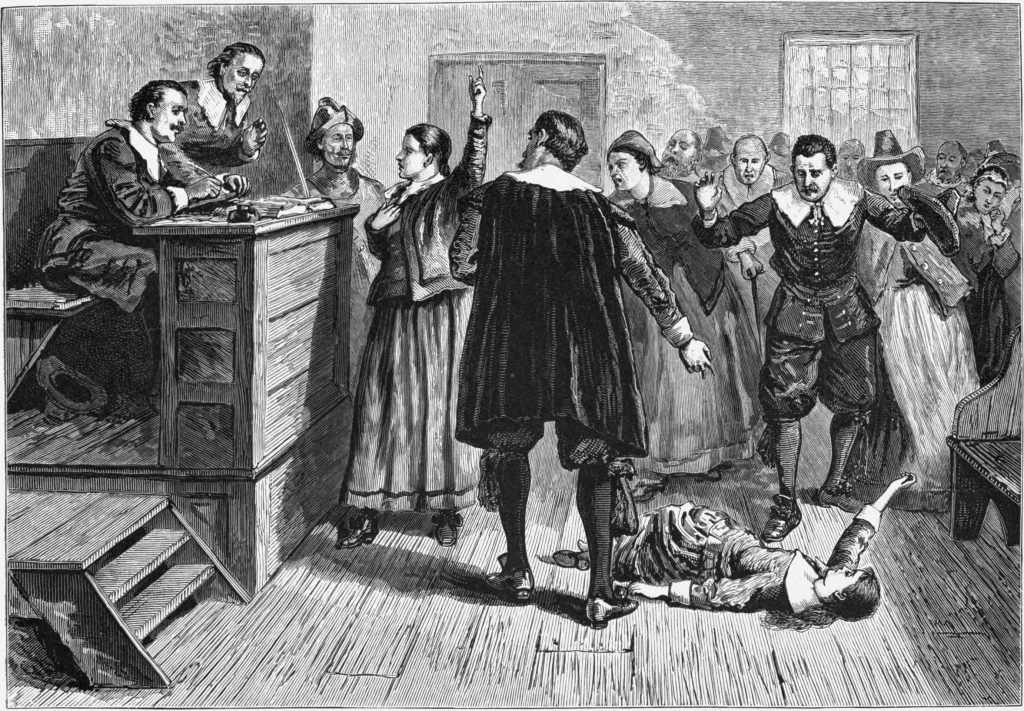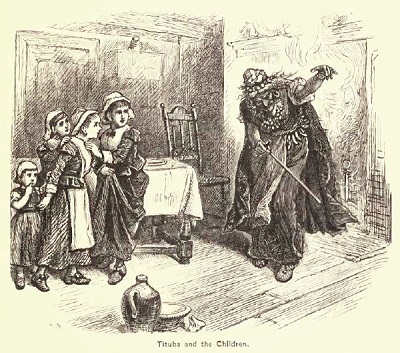The Salem Witch Trials were an infamous series of events occurring in early 1692. In Salem Village, Massachusetts, two young girls were accused of being possessed by the devil after falling seriously ill. Following this incident, the village filled with panic and terror and resulted in twenty executions.
Nine year old Betty Parris, the daughter of Reverend Parris, and her eleven year old cousin Abigail Williams both became ill in February of 1692. The two began to have fits that were said to be even worse than epilepsy and were quite unnatural. Their fits consisted of them throwing things, screaming, crawling under furniture, uttering strange sounds, and contorting their bodies into unusual positions. When other women began to show similar behavior patterns as these two girls, the people of Salem decided that there could only be one reason for this: a witch had possessed them by the devil.
First, Sarah Osborne, Sarah Good, and Tituba were accused by Abigail, Betty, Ann Putnam, Jr., and Elizabeth Hubbard. Sarah Good was homeless and was known for her begging while Tituba was a slave of the Parris family, Sarah Osborne because she was known to rarely attend church in their Puritan village. On March 1, 1692 their many day interrogations by magistrates in Salem Village began.
They were not the only ones to be accused of witchcraft though. In March, Martha Corey, Rebecca Nurse, and four year old Dorothy Good. Rachel Clinton from a neighboring town was also one of them, though not accused for the same reason. Martha Corey was accused because she did not believe that the other girls were actually possessed by the devil with a witch at fault. Ann Putnam Jr., one of the girls believed to be possessed, claimed that Rebecca Nurse was the one tormenting her with the fits. Dorothy Good may have only been four years old, but that did not stop her from getting accused. Her mother was Sarah Good, one of the first to be accused. Young Dorothy’s confessions added up so that her mother had been consorting with the devil and that she herself really as a witch. Ann Putnam Jr. said that Dorothy would often bite her and other villagers like animals and described her to be deranged.
The accusations and arrests did not stop. So many people were accused and put on trial. Members of the local magistrate and governor’s council John Hathorne and Jonathan Corwin were tasked with interrogating Rebecca Nurse’s sister Sarah Cloyce and Elizabeth Proctor. Both Elizabeth and her husband John were put on trial, sent to jail, and ultimately hanged for witchcraft. Abigail Hobbs, Bridget Bishop, Deliverance Hobbs (Abigail’s stepmother), Giles Corey (Martha Corey’s husband), and Marry Warren (one of the Proctor’s servants). Abigail and Deliverance Hobbs and Mary Warren accused others of witchcraft as well including Sarah Wildes, William Hobbs (Deliverance Hobbs’s husband), Mary English, Edward Bishop, Jr. and Sarah Bishop, Nehemiah Abbott Jr., and Mary Eastey (Cloyce and Nurse’s sister). Nehemiah Abbott Jr. and Mary Eastey were both released for various reasons due to false accusations. More and more villagers continued to be arrested. The accusations did not stop either, and by May, so many had been accused, though most had prevented being arrested and put on trial. On May 10, 1692, one of the first to be accused, Sarah Osborne, died while in jail.
Because there were so many villagers accused of witchcraft stuck in jail, it was ordered by William Phips to establish a Special Court of Oyer and Terminer for Suffolk, Essex, and Middlesex counties on May 27, 1692. Warrants continued to be issued to more and more people as more were accused. In total, thirty-six warrants were issued, many of them to people with family members who were already in jail for witchcraft. As of June 2, 1692 there were sixty-two people in custody upon the Court of Oyer and Terminer being convened. William Stoughton had recently become Chief Magistrate and Lieutenant governor. Thomas Newton was persecuting the cases as Crown’s Attorney while Stephen Sewall was a clerk.
The first case that had been brought before the grand jury was Bridget Bishop’s. Because she did not live a puritan lifestyle and wore clothing against the Puritan code such as black colors or other odd costumes, she had been accused. The grand jury ended up endorsing all of the indictments against Bishop. On June 10, 1692, Bridget Bishop was hanged for witchcraft. Indictments against both Rebecca Nurse and John Willard were next endorsed by the grand jury on June 3. Neither of them were immediately sent to trial, unlike Bishop, who went to trial the same day of her convictions. After Bishop’s execution, the court decided to adjourn for twenty days to get advice from some of the most influential and well known ministers in New England at the time. On June 16 another one of the accused, Roger Toothaker, died while in jail.
The grand jury, between June 30 to early July, endorsed many more of the indictments. Susannah Martin, Rebecca Nurse, Elizabeth Howe, Sarah Good, and Sarah Wildes were taken to trial, found guilty, and hanged on July 19, 1692. Mary Lacey Sr. confessed to being a witch along with her daughter Mary Lacey Jr. and mother Ann Foster. Around the same time, the original afflicted girls visited Andover’s constable to see who was causing his wife’s afflictions, which were similar to those of the girls. Anthony Checkley also took over as Crown’s Attorney when Thomas Newton had to leave.
George Burroughs, Mary Corey, Mary Eastey, and George Jacobs Sr.’s indictments were all endorsed. George Burroughs, Martha Carrier, George Jacobs Sr., Elizabeth and John Proctor, and John Willard were all put on trial and convicted. They were all executed on August 19, 1692 with the exception of Elizabeth Proctor. Due to being pregnant, Elizabeth Proctor was not executed right away and instead received a temporary stay of execution.
The jury did not cease to indict accused in September either. William Proctor had been failed to be indicted and was then rearrested, but this time for different charges. Giles Corey was tortured using the peine forte et dure method when he failed to plead during his arraignment. Throughout the month, there were four accused who pleaded guilty but eleven were put on trial and then found guilty by the jury. Eight people were soon executed on September 22, 1692. Both Dorcas Hoar and Abigail Faulkner Sr. (who was pregnant) received temporary reprieves, but for different reasons. The seventy-seven year old Mary Bradbury was able to escape from jail, too.
Governor Phips ordered the Court of Oyer and Terminer to be dismissed on October 12, 1692 to put an end to the witch trials. No executions followed because of this order.
By January of 1693, the Superior Court of Judicature, Court of Assize and General Gaol Delivery had started in Salem. William Stoughton served as Chief Justice, Anthony Checkley as Attorney General, and Jonathan Elaston as Clerk of the Court. Sarah Buckley, Rebecca Jacobs, Margaret Jacobs, Job Tookey, and Mary Whittredge were all tried. These five had previously been indicted in September before the court had closed. None of them were found guilty. In fact, only three of the sixteen remaining accused in jail were found guilty that month, Elizabeth Johnson Jr., Mary Post, and Sarah Wardwell. Governor Phips decided to issue pardons for these three before their executions and let them live.
Five more were tried in late January and early February in Charlestown, Middlesex County: Mary Taylor, Mary Toothaker, Lydia Dustin, Sarah Dustin, and Sarah Cole. Though none of them were found guilty, they had to first pay jail fees to be released. Sarah Dustin was never able to do so and died while still in jail on March 10, 1693.
The Court convened at the end of April while located in Boston, Suffolk County. Captain John Alden was cleared by proclamation. Mary Watkins was put on trial though for apparently accusing her mistress falsely. The infamous Salem Witch Trials were finally over in May when the Court convened in Ipswich, Essex County. Eunice Frye, Mary Barker, Mary Bridges Jr., Susannah Post, and William Barker Jr. were put on trial but found not guilty by the jury.
For a person to be accused and arrested, a complaint must have been filed to the local magistrates from someone who had been ill or usffered through a loss at the time. The magistrates would arrest those whose accusations were credible and real. To get the accused to confess, the magistrates would then bring them in for a public examination/interrogation until they got the answers needed. Afterwards, the magistrates let the superior court deal with the accused and their punishments. A Court of Oyer and Terminer was established in 1692 when the magistrates received help from the governor. Witnesses would then be summoned before the grand jury to decide what would happen.
There were two ways to be indicted: witchcraft or unlawful covenant with the Devil. If the accused was indicted, then it was time for a trial. In some cases, the defendants were indicted and tried on the same day, like Bridget Bishop on June 2, 1692 for example.
In all, nineteen people were convicted and executed, many on the same day. Bridget bishop was the first to be executed on June 10, 1692. After that, there were five executions on July 19: Rebecca Nurse, Sarah Good, Elizabeth Howe, Susannah Martin, and Sarah Wildes. More were executed on August 19, which included George Burroughs, George Jacobs Sr., Martha Carrier, John Proctor, and John Willard. The final executions occurred on September 22, 1692: Martha Corey, Mary Eastey, Mary Parker, Alice Parker, Anna Pudeator, Wilmot Redd, Margaret Scott, and Samuel Wardwell Sr. Giles Corey, however, was eighty-one years old when he was pressed to death, while everyone else had been executed by hanging. Corey refused to plea when he was put on trial, so the judges gave him an alternate form of punishment called peine forte et dure. Stones were piled on top of his chest until it was impossible to breath. He died not long after on September 19, 1692.
Overall, there were many villagers residing in Salem Village that were accused, but were either acquitted, reprieved, or unindicted. Seven people died in prison. Ten people were able to escape prison and/or Salem during the trials, and nineteen people were executed by hanging, one pressed to death.



